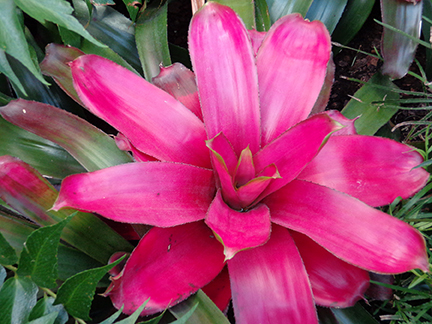 David Trinklein – University of Missouri
David Trinklein – University of Missouri
When it comes to plants with beautifully colored leaves and novel flowers, the bromeliads have few rivals. These durable members of the pineapple family are native mainly to the tropical Americas. Many are epiphytic and grow in the branches of trees in decomposing organic matter. Others are terrestrial and have normal roots systems. In all cases, they are characterized by foliage that usually grows as a rosette and is vividly colored or patterned, and unique flowers unlike any other in the plant kingdom.
Bromeliads are so numerous that many do not have common names. Instead, they are known by their genus designation such as Aechmea, Bilbergia, Guzmania, Tillandsia, Vrisesea. When common names exist, they often are very descriptive of the plants appearance, such as scarlet star, painted feather, flaming sword and silver vase.
As houseplants the bromeliads are not demanding and their attractive leaves give them continual interest. Flowers, when produced, are very unusual and more diverse than any other family of plants. The inflorescence of most bromeliads take the form of elaborate and vividly-colored spikes enclosed in a colorful sheath and bract structure. This structure remains attractive long after the true flowers have faded giving the plant extended color. Bracts may survive and be attractive for several months up to a year, depending on species and environmental conditions.
Because many species of bromeliads are epiphytic in nature, they have the unique ability to trap and conserve water. The center of the rosette formed by a bromeliad is known as its “cup.” In nature, this cup fills every time it rains and serves as a source of water. Additionally, the cup collects insects and debris which, as they decay, serve as a source of nutrients for the plant.
For best indoor performance, bromeliads should be located in bright, diffused light. Those species with hard, thick leaves (e.g. Aechmea fasciata) can put up with brighter light compared with species that have soft, thin leaves. There are no species that perform well indoors under poor light conditions.
In nature, ephiphytic bromeliads grow without soil, clinging to trees for support. Even the terrestrial types grow in rocky soils that hold very little water. Therefore, a well-drained growing medium is needed in order for bromeliads to thrive as indoor plants. Shredded bark, leaf mold or peat moss combined with bark, perlite, coarse sand or clay pot shards can provide the aeration and necessary drainage.
In the home, bromeliads need only light fertilization at monthly intervals when the plants are actively growing. Although they need constant moisture around their roots, excessive moisture encourages root rot. Keeping the cup full of water is considered by many to be a good growing practice.
Bromeliads are not overly particular when it comes to temperature. Those temperatures maintained in the average home for human comfort will also suit most bromeliads. Although bromeliads prefer high humidity, those with thick, leathery leaves are tolerant of the lower humidity levels found in most indoor settings.
Fairly slow to propagate, bromeliads can either be grown from seeds or vegetatively propagated. The latter involves removing and rooting naturally occurring offshoots (pups). Because many of the more attractive species grow rather slowly, the initial cost of a bromeliad sometimes is higher than that of other indoor plants. However, their novelty and durability make them a worthwhile investment.
Some of the more popular bromeliads include silver vase (Aechmea fasciata), triblushing (Neoregelia carolinae ‘Tricolor’), scarlet star (Guzmania lingulata) and flaming sword (Vriesea splendens). All are ephiphytic bromeliads that enjoy warm temperatures and are relatively easy to care for in the average home.
As mentioned above, flowers are not common on bromeliads. Most nurseries that produce bromeliads force them into bloom to make them more attractive at the point-of-sale. This often is accomplished by exposing the plant to chemicals such as Ethephon which cause the plant’s cells to release ethylene. The latter is a plant growth hormone which promotes senescence or biological aging.
The same tactic can be used to force bromeliads into bloom in the home using an apple. Place the plant in a clear plastic bag with no holes in it and add an apple. Apples naturally produce significant amounts of ethylene as they ripen. Allow the plant to remain in the sealed bag (with apple) for about a week or 10 days, making sure the plant is not exposed to excessive light while sealed inside the bag. Finally, remove the plant from the bag and place it in its normal location in the home. Depending on species, evidence of flower initiation should occur within about six weeks.
It should be noted that a bromeliad plant flowers only once and then (slowly) dies. The flowering process will, however, encourage the plant to produce offsets as well. These offsets can be removed from the plant to propagate more bromeliads, or allowed to remain on the plant and induced to flower using the process described above.




